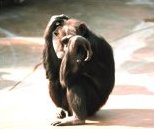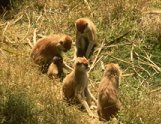All
animals adapt to new ecological niches
by changing physically over many
generations and by altering their behavior. For most animals, behavioral
patterns are predominantly determined by genetic inheritance. Such genetic patterns
usually are slow to evolve. It is often many generations before
appreciable change occurs. Innate behavioral patterns are characteristic
especially of non-mammal species.
 |
| Birds have innate abilities to construct species specific forms of nests |
In contrast, a large part of primate behavior is learned rather than genetically inherited. As a result, it can be variable from population to population and even from individual to individual. It also can change dramatically in relatively short time periods. Given the potential variability in behavioral patterns within a primate species, problems arise about the validity of field studies. It is difficult to make valid generalizations without studying many different communities.
It is important to keep in mind that despite the fact that behavior patterns of humans and other primates are mostly learned, they are still influenced by our genetic inheritance and external circumstances. Our personalities and emotional states are strongly affected by such things as internal hormone levels and stress inducing situations. However, the manner in which we cope with these stimuli is largely learned from other members of our society as we grow up. We learn appropriate and inappropriate responses. These responses are often gender and age specific. Suitable male behavior may be different than that of females. Likewise, adult and child behavior often differs. We also learn a range of skills that help us better adapt to our environment. This makes primates relatively flexible in their adaptations and allows them to successfully respond to changing environments.
Early
primate behavioral studies were conducted mainly in European and North
American zoos. During the late 19th and early 20th centuries, it was
common for different species to be kept at high densities in the same caged enclosure. Virtually no attempt was made to duplicate natural primate
habitats or to provide adequate territories. Individuals were moved
in and out of enclosures without concern for the negative impacts on mental
health and social
groupings. The result was often high stress levels that were expressed
in abnormally anxious and aggressive behavior. Not surprisingly, early
primatologists
![]() often overemphasized primate aggression
because of the intense, often threatening interactions they observed.
often overemphasized primate aggression
because of the intense, often threatening interactions they observed.
 |
|
Psychologically
stressed |
Modern zoos usually attempt to rectify the errors of the past by creating primate enclosures that mimic natural habitats. They also try to maintain social group sizes and compositions that are characteristic of the species in the wild. However, even the best zoos fail to provide a truly natural environment. Primate enclosures are limited in size and resources. Group composition and food sources are determined by the zoo caretakers rather than the primates themselves. Even mate selection is usually predetermined for zoo primates. They also have little choice as to whether they have contact with humans. The better zoos work hard to prevent their primates from becoming bored, and they monitor carefully for psychological distress. However, even when primate species are kept separate and densities are low, zoos are similar to human prisons for the more intelligent primates, especially the apes. It is not unusual for them to develop abnormal personalities as a consequence. This can be seen in anti-social behavior such as frequently repeated auto-stimulation patterns and avoidance of social contact. Throwing feces at tourists as well as repeated regurgitation and eating of the vomit are examples of such abnormal behavior. The better zoos try to maintain good mental health for their apes especially by providing more stimulating environments for them. For instance, they hide special food treats in different locations to make a changing game of discovery. In some cases, they also provide televisions.
|
experimenting with ways to intellectually stimulate their apes. This link takes you to an external website. To return here, you must click the "back" button on your browser program. (length = 3 min. 19 secs.) |
 |
|
|
Free-ranging patas monkeys |
The best primate behavioral studies are now done on natural, free-ranging populations. Every effort is made to minimize the effect of contact with humans resulting from the field study. However, the primates are almost always aware that they are being observed and often become familiar and at ease with the observers. It often takes many years of patient observation by primatologists before a reasonably complete picture of individual primate and community life becomes clear. This is due to the fact that primate behavior is complex and varies through time. Ideally, a group of primates is observed in their natural setting for at least half of their lifetime. For most monkeys, this means five or more years. For the great apes, it can be 20-30 years. Jane Goodall and her research group have more or less continuously studied the chimpanzees in Uganda's Gombe Stream National Park since 1960. Long-term studies also have been carried out by other researchers among wild gorillas, orangutans, and some monkey species such as rhesus macaques.